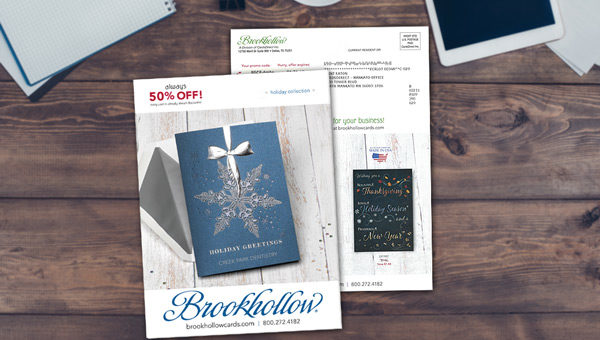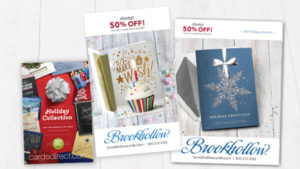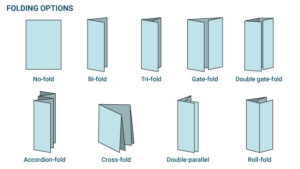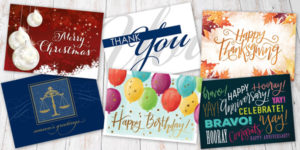
Everything You Need to Run a Successful Direct Mail Campaign
Table of Contents
Creating a print ad that demands action
Tangibility – if you can hold it, see it in your hands, the potential impact can be enormous! With the right branding, the right planning and a measurable strategy, your print mail advertising campaign can be an extremely positive force for your business.
Think, for a moment, of how many digital ads you are bombarded with every day – it’s like millions of flash bombs going off right in your face – it’s blinding – and eventually you stop seeing them altogether – you become desensitized to the glimmer on your computer screen. It’s no secret that many of today’s ads have gone digital, and why not? It’s what we use. It’s how we get our news, view our entertainment, and correspond with each other. It’s ingrained in our lifestyles, which is why a strategic print ad campaign can be a lot more powerful than you might think. Think of it as a love letter to your customers…no noise, no distractions, just you and them communicating…your personal correspondence creating weight in their hands. If your piece of direct mail gets you a second rendezvous with a first-time buyer you’d keep sending them, wouldn’t you? Years later, print communications could be one of the integral pieces holding the relationship together.
But your print ad needs to be quantifiable, it needs to work, and the return must undoubtedly be worthwhile. This guide is meant to honestly display what you’re facing, no smoke and mirrors just the facts of how to orchestrate a successful print marketing campaign – the best ways to go about it, what to anticipate, and how to turn it into that desired bottom line.
Brand Awareness
A large hope for your promotional campaign is to raise brand awareness. Creating a campaign that stands out to participants and generates an ongoing buzz is extremely important. Be clever, be creative, and to loosely quote The Godfather, “Make them an offer they can’t refuse.” Always ensure that your company is remembered in conjunction with the positive offer you have created – make your logo eye-catching and visible, your contact info accessible, as well as easy to use and share. If you wish to evaluate the potential increase in your brand awareness as a result of your print promotion make sure to include a customer survey. Customer surveys will help you to gain specific knowledge about how people view your brand, improve brand familiarity with clients and prospects, and act as a good measuring tool for your efforts – past, present, and future.
Customer Targeting
Which customers are the best? Which ones are going to love your products, love your services, buy the most of them, and give you the most money for them? Your goal is repeat customers with large orders to fill.
RFM stands for recency, frequency, and monetary. Ever heard the saying that “80% of your business comes from 20% of your customers?” Well, it’s more than just a saying, and actually the basis for RFM analysis. The three terms in the acronym refer to a customer’s purchasing habits – how recently they have bought from you (recency), how frequently they buy from you (frequency), and how much they are willing to dish out to your one-of-a-kind business (monetary). Based on the three points of RFM, customers are given a rating for each letter, from one to five. Five being the most valued. Numerically, the idyllic customer would equate to 555.
Building a circulation plan or figuring out the specific customers to target, and with what, is essential to a successful print mail campaign. Know the purchasing habits of your customers. What are they into? What have they bought from you in the past? Depending on the circumstances, you may not want to sell them the same product over and over again, especially back-to-back. Common sense would assume that if they just purchased a large order for a specific product or service they may not need it again for quite some time, but this is also relative to the type of business you are running. If you are a grocery service, people may need bulk orders of the exact same products month after month, but if you’re a greeting card company you know that Christmas only comes once a year and the odds of a customer needing 500 holiday cards in July are slim to none. Instead, when running a promotion, offer your potential customers parallel or crossover products – what could they use in conjunction with the products they have ordered somewhat recently? Wine pairs well with cheese, a jacket goes well with a shirt (depending on the season), and so on and so forth. What additional products and services can you offer as complements?
Closely examine past purchasing history and start building a customer profile. Do diligent research – find out as much as you can about your customers – study their demographics, such as their age, location, profession, company size, family size, education, ethnicity, economic capabilities, and other socio-economic characteristics. You should also find out their interests, both in and out of work. Do some light stalking (within reason), figure out what they’re like and then tailor your marketing plans accordingly. The internet is a powerful researching tool, as is social media; meet customers in person if you can, talk to them on the phone, host focus groups, and record all your results. Segment names of customers or businesses based on RFM, this will help you to also keep track of repeat customers or gaps in client orders. The most recent buyers are the ones that are easiest to sell to again. Remember the 80/20 rule. You have a higher likelihood of bringing in the same business or even more business from the customer that purchased from you last year than the one that has been dormant for two or more years. While it is not impossible to reactivate or re-engage that long-ago customer or those who have previously expressed a desire to buy, the further they get away from you the harder it is to get them back. It is always harder to start a new relationship than it is to maintain the relationships you already have. Don’t ever assume that your current customers are there to stay without your continued attention. A multi-buyer or repeat buyer is like an important crop; with careful tending they will bring forth a great harvest. This is not to say, by any means, that you shouldn’t continue to think of new ways to attract new customers, but realize that it costs close to seven times more to bring in new customers than it does to maintain existing business.
Defining an inactive customer is, once again, relative to the type of business you are in and the typical frequency at which regular customers purchase your products and services. If you own a lawn care service – in a geographical location with four distinct seasons, you may well know that your customers only require your business for a few specific months each year. If you distribute specialty vitamins, with a clear supply count, by keeping track of your purchase orders it would be easy to tell when your customers would need to reorder your products. Therefore, a customer that has gone six months without their 30-day supply of vitamins would be a lot easier to label as inactive than a customer who failed to order lawn care services in January.
Prospect Segmentation

Segmenting potential customers allows you to target various groups of prospects based on their wants, needs, and purchasing habits. Creating these groupings gives you the ability to build multiple campaigns targeted toward different markets, for maximum success. It also offers a more personal experience for your customers, which is important in generating long-term business relationships.
Simply put, a prospect is someone who fits the criteria for your products and services. This is not to be confused with a lead, which comes before the above-mentioned term. A lead is a potential candidate for your products and services. Once you go through all the qualities a potential customer would possess in order to want to buy from you, and determine if this lead fits the bill, then they become a prospect. Prospecting is the act of knowledgeably searching for potential customers, and cultivating these relationships, in the hopes of turning them into actual paying clients.
Prospect mailing lists are detailed, well-researched, contact groupings that contain potential customers who could likely benefit from and be apt to purchase your products and services. You can comprise these lists yourself or you can purchase them from a broker service. When purchasing from a broker service, be sure to do a deep inquiry of how the list was compiled first.All mailing list brokers have their own stipulations. Many come with the condition that the list may only be used once – if you are planning to reach out to those prospects again additional fees will be required.
When evaluating potential prospect mailing lists some things to consider are:
- List description: When organizing prospect lists make sure to include detailed descriptions. These descriptions can include, but are not limited to, what names have been used, what was successful, what was not successful, particular prospect information (both broad and individual), and what aspects of the list you would like to use again. Noting what percentage of the list has specifically responded to direct mail marketing is also important.
- The size of the list: A well-performing list with a large universe (number of available names) can be quite valuable. A large universe allows for more targeted segmentation and usage beyond the initial text.
- Selections available: The more detailed your list report is the better. Most lists will provide basic information about its recipients, like recency, gender, and location. Some will offer a more comprehensive look at its names and provide information that can be highly valuable to your business, like various aspects of their lifestyle and occupation.
- Frequency of updating: Before purchasing or renting a list take a look at how frequently the owner updates it. Worthwhile lists should be updated regularly to guarantee the most useful data.
- Hotline names: When renting a prospect mailing list the list owner may indicate hotline names, this is a segment of the list that represents customers who have made recent purchases. This data will likely make the list more expensive
- Average order size: Determine the average order size that comes from each prospect list. While some prospect mailing lists may generate a positive response rate the order sizes may be very low and not produce a favorable ROI.
- The percentage of the list that is direct mail generated: If you are running a direct mail campaign it is important to ensure that any lists you purchase have a good portion of customers who have previously responded to these types of offers.
- List usage report: A list usage report can help you to better determine the effectiveness of its contents based on whether or not your competitors are using it, and which ones.
- Cost per thousand names (CPM): This is the cost of the leads on your list. Be sure to factor in the cost of each list when calculating your return on investment (ROI) in order to make an accurate comparison of their results.
When considering the procurement of a prospect mailing list it is important to understand the sources used for comprising the list. The contacts included in your list can come from a number of different sources, but these sources are typically grouped into three main categories that are referred to as compiled, responsive, and modeled. Sometimes list brokers may use a combination of all three of these.
1. Compiled List
A compiled list is generally the least expensive, broadest, and is typically built from easily acquired public information, including phone books, credit files, and other types of declassified government records. These contacts can be additionally sorted using a range of differentiators, including geographic location, occupation, income, gender, age, ethnicity, and more.
2. Response List
The second type of prospect mailing list is a response list, which can be more effective at generating contacts that may actually buy from you. A response list consists of individuals who have previously expressed interest in your types of products and services. These potential customers have either purchased similar products before or have taken part in some or all of the following activities:
- Magazine and newsletter subscriptions.
- Trade shows or seminars.
- Focus groups.
These contacts have willingly shared their information in correlation with a specific set of industry parameters, making them ideal candidates for similar products and services and the offers you are gearing up to make. Because response lists are so specific they are usually harder to come by, generally contain a smaller number of contacts, and often come with a higher price tag.
3. Modeled List
The last type of list is called a modeled list. A modeled list is the most targeted list type. It can be comprised of information from the two previously mentioned lists (compiled and response). It uses highly specific data to compare and compile prospective customers based on the transactional patterns of customers you already have on file.
Your prospect universe is all the potential customers that lay before you. Based on the lists compiled for these potential customers you must do what is called a merge purge, whereby you eliminate any duplicate contacts along with any names of individual prospects or businesses that may otherwise prove inefficient for your direct mail campaign.
Before sending out your direct mail pieces you should also create what is called a seed list. Adding your name and the names of additional employees who will help monitor your project to your mailing list is known as seeding the list. Doing so will help to ensure that the pieces have been mailed properly, assist you in gauging how long it takes for them to arrive, aid you in monitoring how many times the list is used, and confirm that there are no unauthorized distributions taking place.
Promotions
Promotions and the way they are implemented can be an effective and relatively easily measurable form of print marketing. The hope is that customers will respond positively to your offer, eventually offsetting the discount and advertising costs and leading to a favorable ROI.
Including a promotional link (sometimes called a promo code, source code, or tracking code) on your print mail ad is very important. Customers must enter this code on your website before receiving their discount, allowing you to track them. Using Google Analytics, you can analyze how many visitors come to your site based on the specific promotion being offered via your print ad. The code itself may be descriptive of your promotion, such as Everything25, to indicate that everything on your website will be 25% off. Watch out for confusing characters – zero looks very much like the letter ‘o’so it would be best not to use it in your promo code. There are several other misinterpreted characters as well, the number 1 looks like a lowercase ‘l’ and an uppercase ‘I’ – see…which one is which? There are several such instances like these throughout written communication, so a good rule of thumb is, if you’re unsure just don’t do it – if it’s even slightly confusing to you, it will be confusing to a portion of your customers, and even one misinterpretation is one too many. Your font choices when displaying your promotion code are also critical, as certain typefaces can be very difficult to decipher. It is also recommended that you don’t create a promo code that is case sensitive, it will make it that much harder for the customer to remember and that much easier for them to get it wrong.
There are generally two main types of promo codes; a single use code and a bulk use code. A single use code is more easily tracked, giving you a clearer path back to its original user. It can also help regulate promo code usage to those it was specifically intended for. A bulk use code can be implemented by multiple individuals, making it fair game for coupon sites and other shareable outlets that utilize both digital and tangible forms of unauthorized distribution. The downfall to a single use promo code is they are oftentimes more difficult to set up from an admin perspective.
Tracking a purchase made online in conjunction with a digital ad campaign is oftentimes easier than calculating the direct purchasing path initiated by a print ad. It is important to note that you cannot completely attribute each customer order to a specific ad or promo code included on a direct mail piece, as there are multiple sources that can be responsible for a buyer’s decision. It is impossible to know, with total accuracy, the thought process behind each customer purchase. Though, you can certainly make an educated hypothesis. When testing the success of a particular promo code included in a direct mail ad campaign you should always run a matchback, which is simply comparing the list of campaign recipients to the people who made a purchase.
You should measure the success of your sales during your print campaign against the average level of sales in the months prior to the campaign, adjusting for any outside factors that you are aware of, such as seasonal sales jumps or opposing declines that you have noticed in the previous years. Whether you are in one of the many industries that banks heavily on seasonal purchases or your business is affected only minimally by such buying habits you must keep track of when these purchases are made, and what they are for, to avoid repeat or unnecessary offers. You should implement two designated periods for evaluation before and after any promotion. The amount of time measured before the promotion should be equal to the amount of time the promotion runs. The period for which the volume of sales is measured after the promotion should typically be double that of the promotion itself. Say for instance that your promotion is one week long; in this case, you would closely observe sales one week before and two weeks after – at a minimum. This is meant to examine a potential drop in sales before the start of the promotion, as well as a continuing rise or fall in sales after the promotion has concluded. A drop in sales volume before the promotion could likely be anticipatory buyer hiatuses, as they are holding off making a purchase until the deal is set in place. Dips after the promotion could be as a result of the same thing…the deal is over, as is the buyer rush, and so is the jump in sales.
Collateral

A large aspect of planning your print mail campaign is choosing the right piece of collateral, whether it is a catalog, postcard, brochure, greeting card, or letter. Then you must consider all the specifications that fall under these forms of direct mail, like:
- Paper type.
- Size and format.
- Number of pages.
- Binding.
- Inserts.
- Postage.
- Envelopes.
- Printing options.
- Design options.
You must also carefully consider the associated costs, which include:
- The cost of mailing the piece.
- The cost of designing the piece.
- The cost of printing the piece.
- The cost of paper.
- The cost of the prospect list.
- The cost of the merge-purge.
- The cost of any special deals you will be offering.
Catalogs

A notable form of print mail advertising is a catalog. The most common catalog sizes are:
- Full size – 8.25” x 10”.
- Slim jim – 5.5” x 10.5”.
- Digest – 5.25” x 8.25”.
When considering the dimensions of a catalog (in relation to postage costs) more and more marketers are choosing what is typically called a “slim jim” catalog. Slim Jims are considered “booklets” by the U.S. Postal Service (USPS), and as such they fall under the “letter mail” category. To qualify for the automated machinable USPS letter rates, the slim jim must:
- Weigh no more than 3 oz.
- Have outer paper stock of at least 50 lbs.
- Must have the address running parallel to the longest side of the catalog.
- Have a trim size with an aspect ratio between 1.3 and 2.5 (aspect ratio is calculated by dividing the longer dimension by the shorter dimension).
- Be at least 3-1/2” x 5” and 0.007” thick and no bigger than 6-1/8” x 11-1/2” and 0.25” thick.
- Have two tab (wafer seals) enclosures.
In some cases, smaller catalogs may generate a better response, but this is not always true. Consider the slim jim option noted above. The wafer seals, used as enclosures, receive optimal postal rates but can deter customers from opening your catalogs because it requires additional effort on their part. Even a slight frustration can cause your potential customers to move onto other things. You want to make it as easy as possible. On the other hand, a slim jim catalog may be just what you need. For certain niche markets, product ads, and in conjunction with a multifaceted campaign (featuring catalogs of various sizes) a smaller catalog may be ideal. Bottom line, there’s no one right answer when choosing the best catalog size.
It is good to talk to your printing company about pricing options as it relates to catalog size and page count – sometimes, based on how the pages are printed, the less expensive option may not always be the least number of pages or the smallest dimensions.
Paper Type

When choosing the kind of paper to use for your catalog there are many factors to consider:
- Size
- Weight
- Finish
- Opacity
The most common sizes for a catalog are 8.25” x 10”, 5.5” x 10.5”, and 5.25” x 8.25” – based on the design you are looking for you will typically choose between these three. The paper weight of your catalog paper should be good quality, and depending on the type of catalog you are sending the recommended weights are 70lb. coated, 80lb. uncoated, or 100 lb. coated. Some catalogs may require a more professional look than others. Perhaps you send a catalog once a year that features all your most sought-after new products – for this, you may want to use a heavier-weighted paper. For frequent catalogs, with weekly or monthly highlights, the more cost-effective option would be to go on the lower end of the spectrum listed above.
The finish on your design will also reflect what type of catalog you are sending. Uncoated paper, also known as white offset, is typically used for booklets – it is standard and professional. If you are going for a catalog with a little more pizazz you can choose a coated finish. A glossy finish is ideal for product photos, as it will really make those colorful images pop off the page, offering a slightly reflective surface that is smooth to the touch.
The opacity of your paper is an important thing to consider as well, as lower-grade papers can show through. Test the weight and brightness of the paper when matched with the amount and type of ink you will be using.
Lastly, if you are looking to ‘go green’ when choosing your paper you should research whether your printing company is offering FSC or SFI certified paper. Both are environmentally-friendly options. FSC and SFI are two programs that are highly proactive in protecting our forests, as well as the animals and indigenous people who inhabit them – they also look to preserve water quality across the world. Some printing companies will additionally recycle paper scraps and other byproducts during the catalog-making process.
Cover
The cover is what will draw prospects into reading the rest of your catalog – so make it count. Ensure that your catalog includes enticing graphics, solid benefit claims that showcase your most popular products or services, and captivating copy that will get readers excited about the offers inside. You can even make a really great offer right on the cover. Remember to include a headline that generates positive thoughts – life improvement through the introduction of your business. Lastly, you should feature your company name and some essential contact info in case potential customers want to get ahold of you quickly.
Folding covers are a way of adding additional dimensions to your print mail piece. A barrel cover utilizes multiple unfolding panels on the cover of your catalog to display various parts of an offer –based on the specific design-style of your catalog it can be a great way to grab your recipients’ attention. A French gate segments the cover of your catalog into two equal flaps that open in the middle – use a French gate as a promotional teaser to what’s inside!
Bands & Wraps
A belly band is a customized strip that fits around your catalog – readers must remove this belly band before opening the pages. You can create a stylish belly band with an eye-catching design and enticing promotional info that directs recipients to read on for the offers enclosed. Because recipients have to remove the band wrapped around the front and back of the catalog before opening the pages they are likely to notice the information on those two sides first – so keep that in mind and use it to your advantage.
There are many different types of promotional formats that one can use besides the belly band. Cover wraps are stapled to your catalog and only partially wrap around your cover. These are promotional pieces in themselves and can offer exciting news about your business. For a seamless look, blend the design on your wrap with the design on your cover or take the opposite approach and create a visually stunning contrast with a wrap that pops against your cover imagery. Typically, wraps will cover half of your vertical image on the front of your catalog. Another good idea may be to create tailored wraps for specific types of customers or regions. If you are using an envelope when enclosing your catalog or other print mail piece you can even opt for wraps on them as well.
Binding

Most often, multiple pages of your catalog will be printed on one sizable sheet called the signature. This signature will be folded in such a way to present your catalog pages in proper order. The binding method will typically be determined by the number of pages you have.
Saddle stitching is the least expensive and most basic form of binding, normally used for catalogs and brochures with a smaller number of pages.The pages are stapled together and trimmed down to a specific size.The turnaround time for saddle stitching is quick, and the process is usually offered in-house at most printing companies with multiple customizations available, including specialized foldouts.
There are some limitations that come with saddle stitching, including its longevity. The wire stitching can tend to weaken the paper, so for heavier-use catalogs you may want to consider another option. As previously stated, saddle stitching is used for smaller catalogs and thicker documents will call for another method. Due to the way the pages are printed and fastened you will have additional restrictions on individual paper variations, such as color. When the decision is made to have a specific page colored it will affect the color of other pages, making it difficult to pick and choose the exact page numbers you want to be altered. One more limitation that comes with saddle stitching is the lack of a printable spine – if this is a customization that you deem important for aesthetic or marketing purposes you will have to choose another binding option. Subsequent adjustments may need to be made for creep caused by this type of stitch, as saddle stitching can cause the inner pages of a booklet to jut outwards from the seam when folded.
Perfect binding is another option for your catalog, but you can anticipate a print cost of about 10-15% higher. Perfect binding is most commonly used for catalogs with several pages and is done by gluing the pages together and then wrapping the cover around them. Unlike saddle stitching, perfect binding does offer the option of a printable spine; it is also longer lasting and provides a nice visual appeal. However, a catalog put together with perfect binding will not lay flat when opened, as it would with saddle stitching, therefore your booklet will close if your recipient isn’t holding it – making it difficult for hands-free reading. Perfect binding is not recommended for instruction manuals and similar intensive reading pamphlets.You will also lose a bit of design space where the pages are glued together, and the turnaround time is often a day more.
Inserts
When putting your catalog together you may also want to add an insert. Adding inserts to your catalog can be a great way to showcase additional offers. A bind-in insert is one that is attached to the inside of your catalog and is typically the size of a postcard. A blow-in insert is an unfastened promotional card, simply placed inside your catalog during assembly.
Postcards
Instead of a catalog, other forms of print mail marketing that you may want to consider are postcards, brochures, greeting cards, and letters. Postcards are direct, inexpensive, and will help to quickly showcase a message to potential customers without much if any distraction. While catalog browsing may require prospects to look for the deal they really want, a postcard will display your can’t-miss offer on a single sheet. There isn’t even an envelope to open, and the first-class postage is super cheap. You can also signify that the postage has been paid for using a personalized artwork box at the top right-hand corner, called your indicia. To qualify for a first-class postage price, your postcard must be:
- No less than: 5” (Height) x 5” (Length) x 0.007” (Width).
- No more than: 4.25” (Height) x6” (Length) x 0.016” (Width).
Brochures
You may also want to consider sending a brochure; this allows you to pack in more content than a postcard at a lower cost than a catalog.There are several different types of brochures, including:

- No-fold brochures: Just a fancier way to say flyer.
- Bi-fold brochures: Also known as half-fold brochures. These brochures use just one actual fold to create two panels.
- Tri-fold brochures: Also known as c-fold brochures. These brochures are made up of just two actual folds, creating3 panels.
- Gate-fold brochures: Also known as window-fold brochures. Two folds meet at the front, forming a gate over the interior panel.
- Double gate-fold brochures: Very similar to a gate-fold brochure, but with one additional fold added, creating four panels in total.
- Accordion-fold brochures: Also known as z-fold brochures. Four folds create five panels that open like an accordion.
- Cross-fold brochures: Also known as French-fold brochures. One horizontal fold and one vertical fold are added to a sheet to create four equal sections.
- Double-parallel brochures: Also known as double-fold brochures. A sheet is folded in half and then in half once again to create four panels.
- Roll-fold brochures: Starting from the right of the page, a sheet is folded inwards to create at least four panels. The left of the page is then folded over these sections.
The typical sizes for a brochure are:
- 5” x 11”.
- 5” x 14”.
- 11” x 17”.
- 11” x 25.5”.
The paper type, finish, and included content are all important aspects of the brochure. Most brochures are printed on thick, quality, high-gloss paper to properly accentuate colorful graphics and text. Brochures are best used at trade shows and other high traffic events; they can be handed out or placed in plain view at various hotspots. Brochures are also commonly inserted into newspapers, but can be tabbed closed, postmarked, and mailed, or inserted in the proper envelope and sent out to recipients. Typically, if your brochure is one ounce or less it will require two 1” tab seals, if it is over an ounce two 1.5” tab seals will be necessary.
Greeting Cards

A greeting card is another form of print mail marketing that is friendly, professional, and highly effective. It lets customers know that you are thinking of them, and have put forth the additional effort to reach out with a tangible greeting instead of an impersonal email. Plus, you can include your company branding on the card and use a unique design and message specific to your business’s personality.
Many customers will make purchases based on emotions. Long-term customers stay based on the continual validation of these emotions. If you consistently reach out to your customers to show you care, in a way that connects with them on a deeper level, it goes beyond the actions of what a typical company would do – they will surely notice and act accordingly, reflecting their actions in their purchasing habits. Many companies send greeting cards at the holidays – stand out and do more. There are plenty of great occasions to send greeting cards – birthdays, anniversaries, the first day of summer…a simple thank you can be sent at any time. And for those customers closest to you, send sympathy and get well cards when the situation calls for it, they’ll appreciate it more than you know, even if they don’t say so.
There are multiple card sizes, but be aware that the size of your card can affect your postage costs. There are also a number of unique high-quality paper stocks that you can choose for your greeting, like textured linen, satin finish, and high-gloss. You can even customize your envelope; choose a particular color, pick out a foil lining, add a personalized stamp, as well as a return address label, and include the recipient’s mailing address in a stylish font and appropriate color.
Letters
Sending a letter to prospects is another nice way to form a connection, stay in touch, and market your business. To qualify for the postage cost bracket associated with a letter your piece of mail must be:
- No less than: 3.5” (Height) x 5” (Length) x 0.007” (Width).
- No more than: 6.125” (Height), 11.5” (Length) x 0.25” (Width).
Use an envelope that stands out, not a boring #10, as it will likely be labeled as ‘junk mail’ and end up in the trash. Experiment with different colors and shapes, or better yet, customize your own using original artwork, branding, and stamps. Then the age old envelope question…window or no window? If it’s simply to show the address, it will save you a bit of time and money when mailing out to the masses, as individual address labels will not be needed. However, you are verging on boring envelope territory again. If the majority of your letters end up in the trash your time and money were for naught. In many cases, a closed envelope is more personal and more stylish. Experts also believe that people are more likely to read your letter if they are hand addressed.
There are exceptions when it comes to envelope windows. If you are using your envelope window to showcase a unique message, clever branding, or an eye-popping image then, by all means, go for it! The more you positively stand out to recipients in the seconds before potentially viewing your offer the better your chances are for profiting from your campaign.
Some believe that simple is better and, in certain cases, they might be right. Simply hand addressing your envelope and including no other identifying marks can add a mysterious quality to your letter and entice your recipient to find out what’s inside.
Use real stamps. A bulk mail stamp screams junk mail. They may be cheaper, but you will likely lose way more on the campaign itself. Don’t be stingy, send priority mail. If recipients are privy to a visible sign that you spent extra money on postage they may consider the letter to be more important.
The type of paper that you use for your letter is of great importance as well, and will usually be your largest expense. While a high-quality paper may be tough on the wallet, initially, it reflects the type of company you are running and will be viewed as such by your recipients, whether consciously or subconsciously. Though every scenario is different, more professional and significant letters may call for a superior paper stock versus a more casual correspondence that would be represented just fine on standard paper. It also depends on the type of artwork you are incorporating into the letter, if your artwork is going to cover the entire sheet then bright white paper may not be necessary, though a colorful image may lack luster on low-quality paper. If your recipients are more environmentally conscious you better make sure that your paper is recyclable – look into Forest Stewardship Council (FSC) certified paper. And remember, talk with your suppliers about cost-effective alternatives, house brands can offer the same characteristics as many of the more expensive papers.
A/B Testing
A/B testing is comparing the success of two versions of a marketing campaign. Ideally, the two versions (A and B) being tested are identical except for a single variation that has the potential to impact a user’s behavior. Variations take many forms – they could be offers, creative changes, list segments, and so on. Your control version (A) is your constant that is matched against the test version (B) that includes the variant. A test can be run multiple times to determine a winner, but additional tests will not necessarily produce different or actionable results. Ideally, a winner is determined, and this becomes your new control. Testing is a continuous process to determine your optimal marketing campaign.
Make sure to designate an appropriate amount of time for your test, and a suitable number of responses, in order to get effective and statistically significant results. Test your campaigns using two identical groups of customers. In certain cases, it is good to test with an equal number of men and women. Use only a small percentage of your list – roughly 10%. Consider multiple factors when planning your test groups, including those who purchased from you most recently, their age, location, order size, and any other demographics that may have a direct impact on your campaign. Create a promotion expiration date – in other words, impose a deadline for when your offer will end in conjunction with your round of A/B testing.
Metrics
Metrics are what allow us to measure the effectiveness of print and other forms of marketing. They help us to better weigh the value of any strategic decision and whether or not it would be monetarily beneficial to make it. Metrics help us to examine results, analyze data, and more efficiently track the rise and fall in a customer’s purchasing habits based off of a specific ad. Key terms and metrics that are essential to your print marketing campaign include:
- Conversion: This is the act of converting a prospect into a paying customer.
- Response rate(Total # of Responses ÷ Total # of Recipients): This measures how many customers you are able to attract during any given marketing campaign.
- Retention rate(Total # of Retained Customers ÷ Total # at Risk): The purpose of the retention rate metric is to measure your ability to attract and maintain new customers throughout the course of your business.
- Attribution: Determining the media efforts that drove paying customers to buy from you. What was the course of events that caused them to buy – what were the steps…and in what order?
- CPN or cost per name (Total Marketing Costs ÷ Total # of New Customers): Compares how much you spent on acquiring new customers to how many you actually acquired – in other words, did you make a profit, was it worth it, did your time and money produce a favorable return on ad spend (ROAS)?
- Return on ad spend (Total Campaign Revenue ÷ Total Cost of Campaign): This measures how effective your ad campaign is by comparing how much you spent to how much revenue it generated.
- ROI or return on investment (Net Profit ÷ Total Business Expenses): Did all the money that you spent(all year) on working to generate new customers lead to an increased net worth, a profit, a favorable bottom line? Then that is your return on investment.
- Attrition or churn rate: Basically defined as the percentage of customers that opted out of your service during a designated time period.
- Lifetime value: The lifetime value of a customer, directly put, is how much money they will generate for your company as long as you, your business, and that customer exist.
Execution
The know-how to run a successful direct mail campaign is in front of you, but you must work to fine-tune your message and your execution. Testing various methods against each other and recording detailed results is essential to advancing with this (and virtually every other) type of marketing. Do not be afraid to fail, but ensure that you have a safety net in place if it happens. A cliché to advertise by is to not put all your eggs in one basket, in other words, distribute your ad budget evenly while continuing to do what you do best – the purpose of marketing is to delightfully show people just how amazing your products and services are. Figure out the best ways to captivate your prospects and continually entice your long-term customers. Present the need for what you provide and continue to get a better understanding of your audiences’ desire to improve a certain aspect of their life. How can you help them do this…and how can you show them that you understand their way of thinking? Speak transparently through your campaigns…relate…your audience has a better radar for honesty than you might expect. Make them happy…and keep them happy…because if they’re happy you’re happy.
About the Authors
Travis Helling and Matt Sizer have over 30 years of direct marketing experience. As experts in their field, they have managed over $35 million in direct mail revenue, across the United States and Canada, generating more than $400 million in sales during their tenure at Taylor Corporation. They have created top-notch print marketing campaigns for over 14 different brands. In one year, their efforts lead to the creation and dispatching of over 29 million catalogs resulting in exceptionally high returns. Brett Miller is a seasoned communications expert who has written numerous articles for nearly every facet of the marketing industry. His insights and contributions have been featured in several noteworthy publications, including the International Business Times, San Francisco Chronicle, and the Miami Herald.
